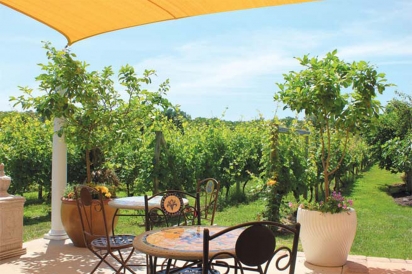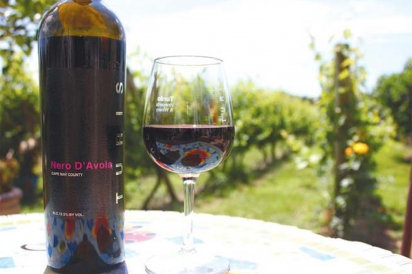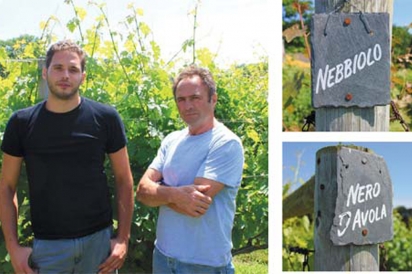Old World Wines, New Jersey at Turdo Vineyards and Winery
At a small vineyard in Cape May, you see fig, apple, peach, persimmon and pomegranate trees before you see a single grapevine.
"Look at the fruit trees we've got here," says Luca Turdo, gesturing from across the bar in the tasting room. "Latitudewise, we're right there with Puglia." Puglia is a region on the heel of Italy's boot, and by linking it with Cape May, Luca is saying that New Jersey belongs in the company of the world's wine-producing regions. Salvatore Turdo, Luca's father, agrees. "Anywhere you can grow fig trees, you can grow grapes," he says.
Salvatore grew up on his family's vineyard outside Santo Stefano di Camastra, a Sicilian town on the Mediterranean Sea. He left for the United States at age 14. In 1998, toward the end of a 28-year career as an electrical contractor, Sal bought five acres in North Cape May with the intent of starting a vineyard on which to eventually retire. Luca, Sal, and Sal's wife, Sara, planted the first 4,000 vines before they finished building the house.
Turdo Vineyards and Winery opened in 2003 – and Sal has yet to retire. Today, the vineyard produces some 1,100 cases of wine a year, all from fruit hand-harvested by Sal and Luca.
Flanked by the Atlantic Ocean, the Cape May Canal and Delaware Bay, the grapes at Turdo mature in a unique microclimate that features a long growing season, hot days but cool nights, and a perpetual off-thewater breeze. The distinctive climate and the sandy soil combine to yield wines that taste like they're from Piedmont or Palermo. It's fitting that Turdo Vineyards specializes in dry Old World wines, such as Barbera, Sangiovese, Nebbiolo and their signature wine, Nero d'Avola.
Cape May is a beach town better known for its bed-and-breakfasts and Victorian architecture than its vineyards and vintages. That perception has begun to change in recent years thanks to the arrival of new wineries throughout the area, including Cape May Winery, opened in 1994; Natali Vineyards; Willow Creek Winery; Hawk Haven Vineyard; and, of course, Turdo. "We try to make the best wine possible using the best fruit possible," says Luca of his vineard's offerings. "All the wine under my father's brand is 100% estate grown – right here on the property." It's sold at the winery, at six area restaurants and at two liquor stores.
Turdo Vineyards looks like a backyard – a backyard planted with 55 rows of grapevines. At the head of each row hangs a square slate scrawled with a painted white script declaring that row's vintage: "Merlot," "Barbera," and so on. The view of the vineyard is best from a seat on the pergola, a porch spotted with wrought iron tables, oak barrels once used for aging wine, various trees (olive, lemon, hibiscus) and bright flowers (snapdragons, petunias). Canvas the color of cheddar cheese casts shade, a languid Spanish guitar flows from the speakers, mosquitoes fall to quick slaps, and a cool glass of rosato (rosé) beads with moisture an arm's length away. Past Turdo Vineyards in the direction of the Atlantic Ocean (and Sicily) looms a dense stand of trees. Fifteen years ago, these woods covered Sal's land.
They began by clearing the trees. Then, vines needed to be planted. After starting with grapes popular in liquor stores – such as Cabernet Sauvignon and Chardonnay – Sal shifted to funkier Old World varietals once the vines matured some and he had established a sturdy customer base. He knows the tips and tricks of the trade from his youth in Sicily, where there was no electricity, goats transported skins of wine to town, and men crushed grapes with their feet.
Nebbiolo, Sangiovese and other wines built for aging thrive over time when the grapes have been grown in a cool climate, like Cape May's. "Here we don't harvest until October," says Sal. "Grapes spend a long time ripening at a slow pace. They have more flavor, structure, aroma and color." The unique environment of North Cape May imbues the grapes with place and complexity. Sal's wines would taste different if made anywhere else.
His 2012 Nero d'Avola gets its punch from tannins. The young wine, although it's ready for drinking now, will soften over time. It swishes around in the mouth paper-dry, a dark wine heavy with dark fruit. It's rugged and refined at once. Across the ocean, a sunburnt Sicilian sailor must be drinking something similar. Somehow, the Cape May–grown wine feels like a vinous version of Sal, a Sicilian-American who spends half the week tending a 6,100-vine vineyard on the state's southern tip, and the other half doing electrical inspections up north in Woodland Park and West Milford.
Sal's Sangiovese, berry-forward and mushroomy, will have you living memories of Italy if you've spent time there, and his Merlot cuts fruitiness with smoke gained from aging in Hungarian oak. His citrus-crisp Pinot Grigio swells with apricot, his purple-pink Barbera comes in with raspberry and out with vanilla. He does a Europeanstyle rosé that gets its zip from leaving crushed Merlot grapes in their juices for 24 hours. Four grapes combine for Sal's peppery Persara blend, named in honor of his wife ("per Sara" means "for Sara.") There are others, including an herbaceous Sauvignon Blanc and a Nebbiolo that often sells out.
All are worth a detour on the way to Cape May. What's the family secret? "It's out there," says Luca, pointing to the vines. "That's where it starts. You've got none of this – the tasting room, the patio – without the fruit."









